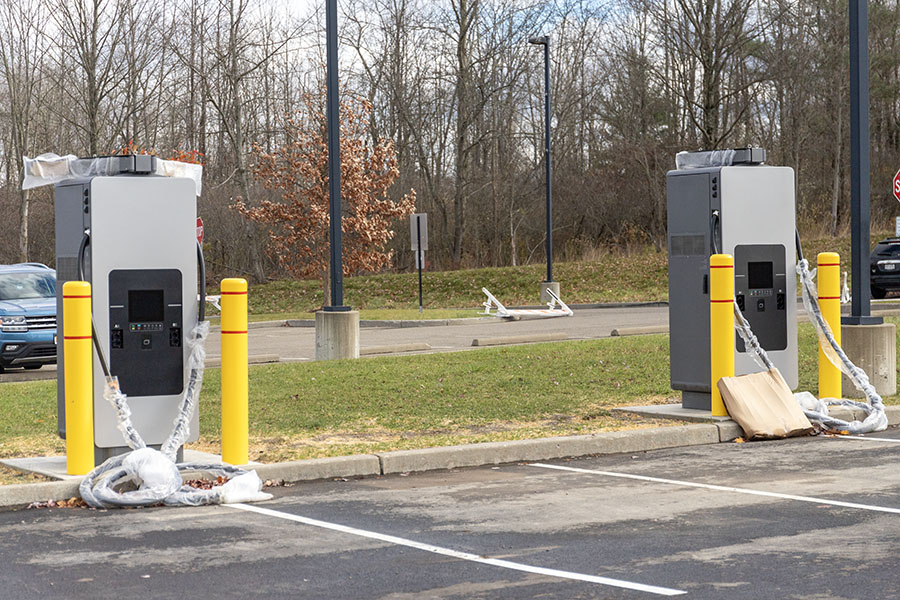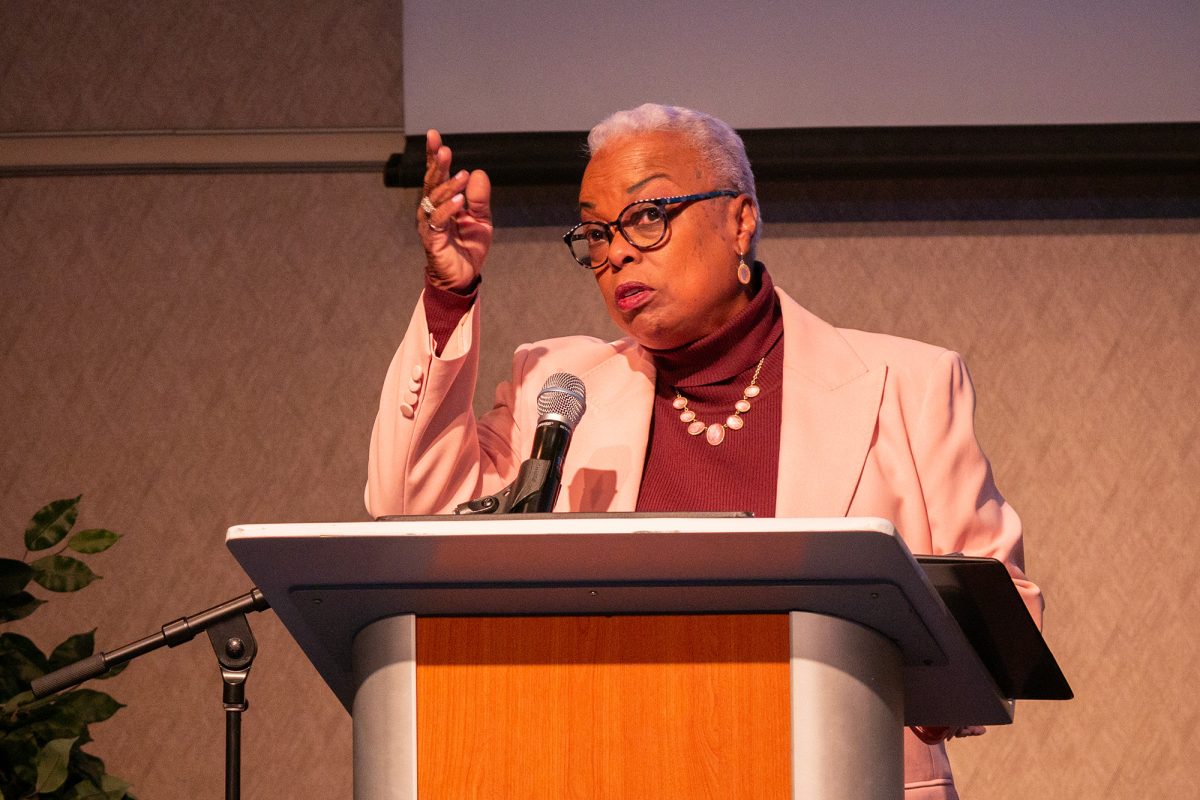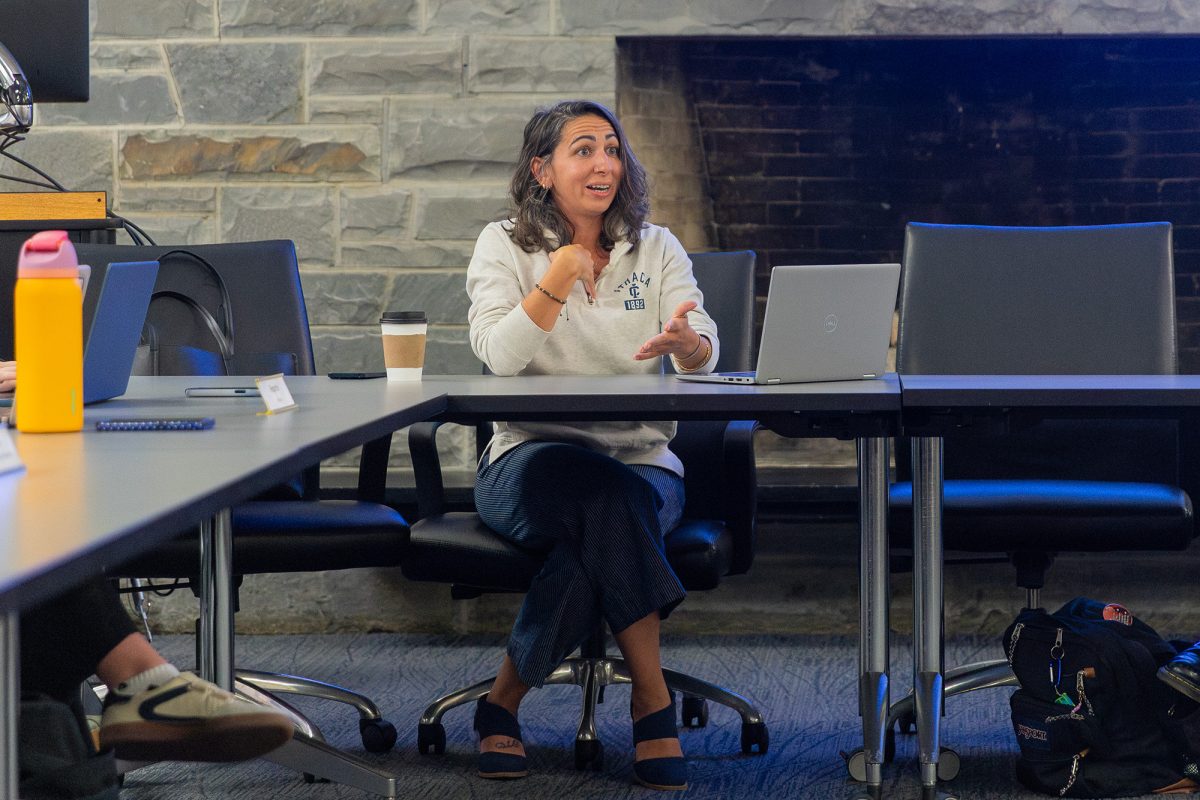Ithaca College will be expanding its on-campus electric vehicle charging stations. In the past, use of an EV charger on campus was free, but now the college will be implementing a fee that will charge users per kilowatt-hour.
By Spring 2025, the campus community and the general public will have access to three new on-campus stations that will be connected to the college’s power grid during the winter break of the 2024–25 academic year. Two superchargers have been added on the south end of the Athletics and Events Center and one dual-port — a charger with two ports on either side to accommodate two users — level-two charger has been installed behind Terrace 13, as well as 26 level-two chargers in the Farm Pond Road parking lot.
Tim Downs, vice president for Finance and Administration and chief financial officer, said the A&E Center, Terrace 13 and Farm Pond Road were all chosen as ideal sites because they are accessible to the public and have optimal electricity access for the chargers. He said the majority of EV chargers were added to Farm Pond Road because the college hopes to increase its EV fleet.
Level-three EV chargers, also called superchargers, charge at 240 volts and typically take 4-10 hours to charge an EV from empty to 80%. A supercharger’s voltage can range based on how much an EV can manage, between 10 to 73 minutes, according to the U.S. News & World Report.
Scott Doyle, director of Energy Management and Sustainability, said the average cost per level-two charger is about $5,000, while superchargers can cost between $30,000 to $100,000 per unit.
Doyle said the college has received grants from New York State Electric and Gas and the New York State Energy Research and Development Authority for the expansion project. The grants require that the college make the chargers accessible to the public. The grant will also require the college to collect data from the EV charger users and send it back to the grants funding the chargers.
Doyle said the college is in the process of setting a formal EV parking policy that will set rates and rules, but have yet to clarify what this will mean. He said the policy will include EV access to the campus community, visitors and the greater Ithaca community.
Doyle said the units will be connected to the college’s power grid once fewer people are on campus.
“[We] don’t want to be disruptive, so we have to make sure [the electricity] is cut,” Doyle said. “We haven’t connected them formally, but they’re being set up … and we have to coordinate power shutdowns, so you’ll probably see them in [December], or maybe January.”
The college’s pre-existing charging stations are located in the Visitor Lot and at the Circle Apartments Community Center. Both stations are equipped with level-two chargers.
Students like sophomore Gavin Garver, who has a Tesla on campus, said they did not know the college had EV chargers on campus.
“I should have done more research into it, considering that I have an EV, but me and my family were mostly like, ‘You have the superchargers down in town that you go to for an hour a day, every weekend,’” Garver said.
Garver said he uses the superchargers located by Trader Joe’s on Meadow Street. He said that the charge takes about 40 minutes and that he typically pays about $20 per charge.
While the college’s chargers are ChargePoint brand, Garver said Teslas are continuously becoming more compatible with other brands of EV chargers.
“You can get attachments for the charger, so that you can allow yourself to use different branded chargers,” Garver said. “And the same goes for Tesla superchargers with different EV cars.”
While the college did not previously have a cost per charge, Downs said all the new chargers will work like a gas station.
Typically, electricity costs are variable and change throughout the day. During the daytime, electricity is higher in demand and costs more, while during the night, electricity costs less. Downs said the college will not charge based on these varying prices of electricity and will charge a fixed rate at several cents per kilowatt.
Although the exact cost per charge has not been decided by the college, Downs said the rate per charge will not deter people from charging.
“We will make sure [people with EVs are] not going to pay more than what they pay to charge at home,” Downs said. “I would be surprised if we charged that high, so I am expecting that we will be below what people pay at home.”
The average cost per charge for an at-home EV charger is about 16.63 cents per kilowatt-hour or about $67 per month. Installation costs of at-home charging ports vary with the different kinds of chargers. An at-home level-one charging port is on average $400. A Tesla level-two charging port can cost between $200–$500 and an at-home supercharger’s installation can cost up to $50,000 depending on the usage of the car.
“[Homeowners] pay a residential retail rate,” Downs said. “Our industrial rate is lower than your at-home rate because it’s how much you’re buying. We get a bulk discount essentially because we buy so much more.”
Downs said the cost per charge will help the college build revenue for the installation and electric costs of the EV chargers. He also said there will be additional penalty fees for overstaying the college’s charging time limit of four hours.
Doyle said the NYSEG grant, called the Make-Ready Program, gives funding to communities to install more EV chargers and help install units. He said the college also took advantage of NYSERDA’s state-funded Charge Ready Program, which he said will be used for rebates after the level-two chargers are brought online.
While the Internal Revenue Service is still working on implementing the federal Inflation Reduction Act, Doyle said there may be another New York state rebate the college can receive, the Alternative Fuel Vehicle Refueling Property Credit. The rebate allows tax-exempt entities like the college to receive payment for their investments in EV chargers. The units the college has installed include network systems that capture user data.
“NYSEG will cover a couple thousand dollars per level-two charger, for example,” Doyle said. “So you document that they’re in use. You make sure that they are the right types of units. But they also collect user information, like how much power they’re using and the frequency of use per unit. Then we kick [that data] back to the state. So if you do that, you get a couple thousand more dollars for that.”
Doyle said the estimated costs without grants and subsidies would have been around $700,000.
“We fully recognize that our EV charger infrastructure is likely not to be fully utilized upon activation in 2025, though these subsidies convinced us that a build out of a larger system would help us build at a scale for the campus community to grow into,” Doyle said in an email.
While the college is receiving grants to expand the amount of EV chargers at the college, Downs said there is still about $100,000 being spent.
“To break that down, that’s pretty darn cheap,” Downs said. “Once you break the ground and you start putting the electrical wires there, you’re much better off [installing] as many as you can.”
News Editor Prakriti Panwar contributed reporting.









